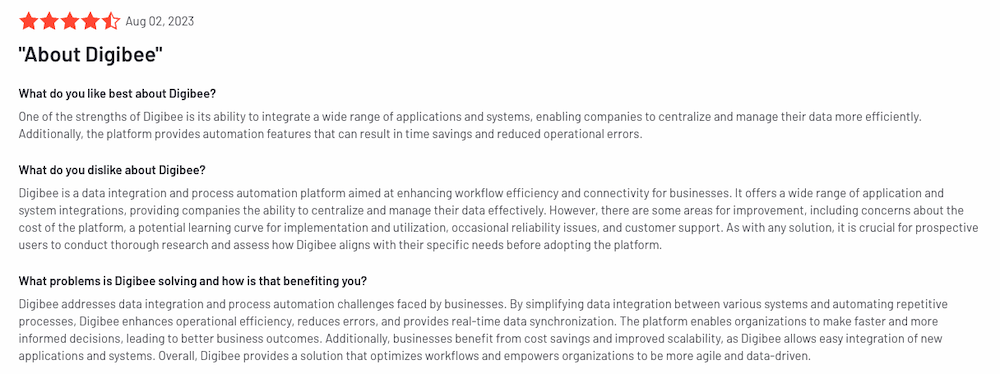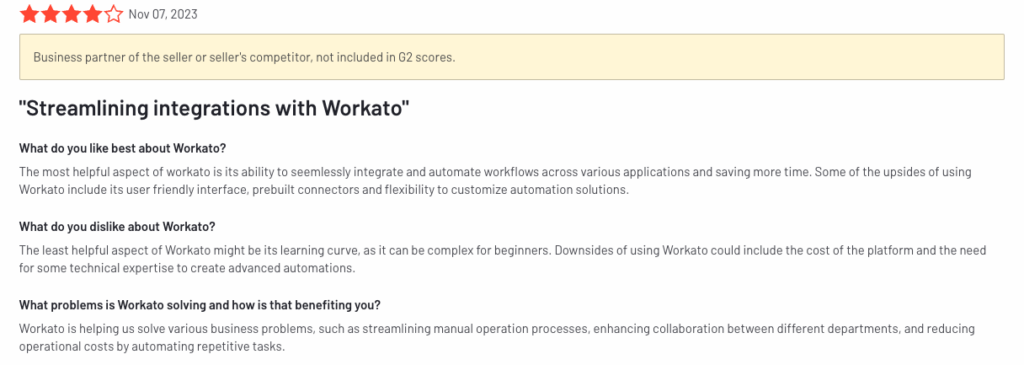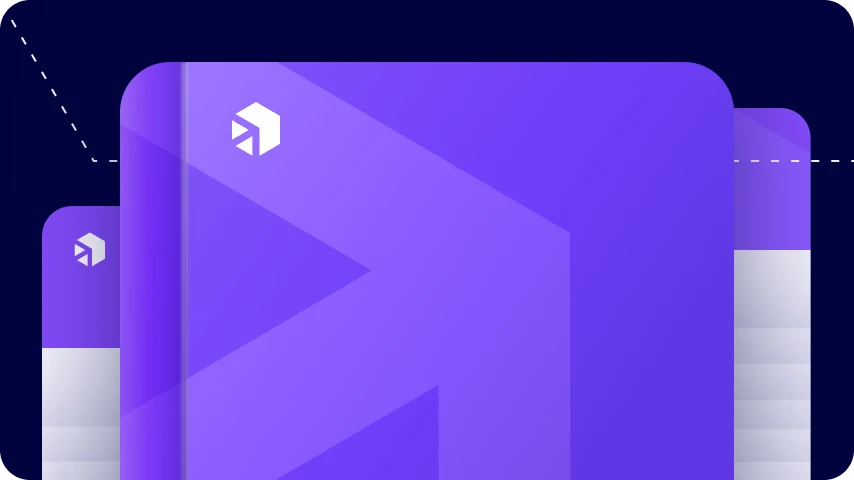
The rapid pace of innovation for integration technology continues unabated. Just a few short years ago, enterprises were committed to cumbersome, on-premises products that required a significant (and ongoing) investment of time, resources, and budget.
Today, enterprise integration is an innovation enabler, helping organizations to digitally transform while accelerating critical technology advances.
No longer married to legacy on-premises technology, enterprises are rapidly shifting to the cloud. Modular IT infrastructure supports greater agility and speed, ensuring a profitable and enduring successful business.
This updated buyers guide provides a detailed overview of integration platforms so you can compare vendors based on these important key considerations:
- Ease of implementation
- Price
- Scalability
- Security
- Compliance
What is an integration platform?
Platform integration connects independent software applications to streamline interactions between each app.
There are many different types of integration technology available today, including:
- iPaaS: A suite of cloud services enabling development, execution, and governance of integration flows connecting any combination of on premises and cloud-based processes, services, applications, and data within individual or across multiple organizations. [1]
- Enterprise service bus (ESB): An architecture that supports centralized components that perform application integrations.
- API management platforms: Connecting two or more applications using their application programming interfaces (APIs) to exchange data.
With the shift to cloud-based operations, iPaaS technology is leading the trend.
“iPaaS has moved to early mainstream adoption globally, reaching 20% to 50% of the global target audience who will use iPaaS offerings to integrate not only applications and data, but also ecosystems, APIs, and business processes.”
Gartner Hype Cycle for Cloud Platform Services 2022
Top Five Enterprise Integration Tools
The Digibee Integration Platform
KEY FEATURES
- Born-in-the-cloud platform: easily build integrations with reusable pipelines and capsules
- Low-code interface: No specialized training required, all developers familiar with JSON will be comfortable with Digibee
- Automated alerts: Pre-emptive monitoring of mistakes for immediate resolution
- Global configurations: Manage accounts, API keys, and multiple instances from a single dashboard with on/off toggles for common settings
- Digibee execution panel: Safely test integrations and apply global parameters, deploy in seconds
- Single real-time dashboard: Monitor and troubleshoot integration pipelines across multiple projects, view performance metrics at a glance,classify errors and automate response mechanisms, use pre-built connectors to send data to ticketing systems such as JIRA
- Learn more
REVIEWS



| PROS | CONS |
|---|---|
| – Authentically born-in-the-cloud platform – Implement in weeks versus months (or years) – Works in tandem with existing legacy iPaaS solutions to fast-track stalled innovation initiatives – Accessible to developers of all skill levels, no expensive training or certification required – Simple, all-inclusive pricing model that includes maintenance and support | – While rapidly gaining market share, Digibee is new to the market – Technology focuses exclusively on integration versus broader capabilities such as API management |
CUSTOMERS
- Johnson Brothers (liquor distributor)
- Lowes (retail company specializing in home improvement)
- Payless (international discount footwear chain)
- Additional customer stories
PRICING
Digibee pricing reflects a contemporary “all in one” model that provides free access to the most recent product innovations and capabilities. The pricing is incredibly simple, requiring only three SKUs with no limitations. Rather than charging for potential maximum usage (typical pricing model for legacy iPaaS solutions), Digibee customers pay only for what they consume.
The pricing model is based on the provision of pipelines and Runtime Units (RTUs), as follows:
- Pipeline: An integration pathway that uses a sequence of components to connect systems and establish data flow between them
- RTUs: Runtime Units that support capacity requirements based on concurrent transactions and/or memory
SKU #1
Get Started Bundle
10 pipelines, 20 production RTUs, 10 test RTUs
SKU #2
Additional Pipeline
Additional pipeline, includes production/test RTUs
SKU #3
Additional Capacity
More RTUs as needed within production/test environments
As the customer’s integration strategy expands, additional pipelines and RTUs are added as needed. This ensures the customer only pays for what they use, with per unit pricing going down as the implementation grows.
Digibee customers access all features and capabilities at no extra charge. A new customer can get started with SKU #1 for less than $60,000 USD, including:
- Digibee-hosted iPaaS
- All support and maintenance, 24/7/365, including all new features and upgrades
- Continuous education
- Customer enablement with direct Digibee support to design, build, test, and run integrations
Digibee provides an interactive product tour of the Integration Platform.
RATING
- G2 rating = 4.7 out of 5
MuleSoft: Anypoint Platform for Integration
KEY FEATURES
- Anypoint API Designer: Library of APIs, templates, examples, and connectors
- Anypoint Studio: IDE for integration and API development with prebuilt modules
- Anypoint Connectors: Use a web interface or a desktop IDE to integrate systems)
- Anypoint Exchange: Marketplace for connectors, templates, examples, and APIs)
- Anypoint DataGraph: Reuse, consume, unify multiple APIs
- Anypoint Partner Manager: Accelerate partner onboarding, simplify partner management
- Anypoint MQ: Messaging service for asynchronous communication patterns
- Anypoint Code Builder: IDE to design, develop, deploy APIs, integrations, and automations
REVIEWS



| PROS | CONS |
|---|---|
| – A legacy industry veteran, MuleSoft has a strong roster of established customers that have invested heavily in the technology – Mulesoft feature set is deep, extending well beyond iPaaS capabilities | – Complicated and expensive pricing model – All software developers and architects must be MuleSoft-certified to use the technology and to engage with customer support on any matter – End-of-life cycles are chronic and time-consuming, monopolizing expensive developer resources |
CUSTOMERS
As a legacy technology vendor, the MuleSoft customer base is broad and varied. Customers featured on the company’s website include:
- Airbus
- Barclays
- Citrix
PRICING
MuleSoft pricing is complicated, incorporating two different pricing models: usage-based and tiered. Customers must pay for:
- VCore (to support product usage)
- Edition (gold, platinum, titanium)
- API management (based on usage and volume)
- Integration (three different tiers)
- API Experience Hub (for full API management capabilities)
- Additional capabilities and add-ons are optional
MuleSoft provides a free trial of its Anypoint platform.
RATING
- G2 rating = 4.5 out of 5
- Capterra rating = 4.4 out of 5
For a deep dive of MuleSoft’s legacy iPaaS, read the research paper.
Azure Integration Services
KEY FEATURES
- Logic Apps: Create workflows and orchestrate business processes to connect hundreds of services in the cloud and on-premises
- Service Bus: Connect on premises and cloud-based applications and services to implement highly secure messaging workflows
- API Management: Publish APIs securely for internal and external developers to use when connecting to backend systems hosted anywhere
- Event Grid: Connect supported Azure and third-party services using a fully managed event-routing service with a publish-subscribe model that simplifies event-based app development
- Azure Functions: Simplify complex orchestration problems with an event-driven
- Azure Data Factory: Visually integrate data sources to construct ETL and ELT processes, accelerate data transformation
REVIEWS



| PROS | CONS |
|---|---|
| – Developers working within an existing Azure environment are loyal and may prefer to build and code with Azure tools – Strong API management tools – A large existing Microsoft customer base provides a stable foundation upon which Azure can build | – Simple tools incapable of supporting sophisticated enterprise use cases, with prebuilt connectors limited beyond the Azure ecosystem, difficult with non-API-led connections – Each tool has its own interface to learn and manage; a deep learning curve for all users – Numerous, complex pricing models make it difficult to monitor and control costs |
CUSTOMERS
The large, existing Microsoft customer base presents significant add-on opportunities for the Azure Integration Services. Customers featured on the company’s website include:
- Swiss Re
- Quest
- Mission Linen Supply
PRICING
Azure Integration Services pricing is variable. During implementation, Azure cloud services are required. Additional costs depend upon the number of paid services deployed. Ongoing costs include additional Azure cloud services.
Azure Integration Services offers a free trial or a pay-as-you-go account to test the product.
RATING
- G2 rating = 4.4 out of 5
- Capterra rating = 4.6 out of 5
boomi
KEY FEATURES
- Intelligence: Embedded AI capabilities to build faster and manage easier
- Composability: Reusable building blocks and powerful automatability
- Democratization: UX for all roles and skills supporting role-based access control and team-based development
- Scale: Elastically scale as needed to handle varying workloads
- Security: Built with enterprise-grade security and reliability
- Lifecycle Management: Built-in versioning and governance controls of integrations, workflows, APIs, and data models
REVIEWS



| PROS | CONS |
|---|---|
| – Well-established within the industry with a large customer base – Strong support for remote businesses with infrastructure that requires totally on-premises connectivity – A viable choice for organizations that prefer to outsource integration and instead rely upon Boomi’s prebuilt connections, network of SIs and ISVs, and the Boomi marketplace | – Complexity of use with seven different point products – Expensive with complicated pricing and licensing, each tool has its own volume-based pricing model, all support is paid – Product roadmap weighted towards citizen developers and automation |
CUSTOMERS
- Red Cross Australia
- MOD Pizza
- Boise State University
PRICING
Boomi pricing incorporates a mix of tiered and volume-based pricing. Versions include Professional, Pro Plus, Enterprise, and Enterprise Plus with features varying by version.
Customers must pay for:
- Integration (features and numbers of connectors)
- Master Data Hub (increases in data volume)
- B2B/EDI Management (number of trading partners connected)
- API Management (number of API calls made)
- Flow (number of apps built)
- Data Catalog and Preparation (number of connectors and users)
RATING
- G2 rating = 4.2 out of 5
- Capterra rating = 4.5 out of 5
Workato
KEY FEATURES
- Recipe Design: Customize recipes with different triggers, actions, and other steps
- Connectors: Includes a method of authentication, triggers, and actions for a specific app
- On-prem Connectivity: A secure connection from within a private IT environment to connect to Workato cloud
- API Platform: Turn API recipes into endpoints so others can easily consume data without access to a specific Workato account
- Workbot: Build customizable workflows
REVIEWS



| PROS | CONS |
|---|---|
| – Known for ease of use in building automation in less sophisticated lines of business use cases that focus on citizen developers – Majority of business is embedded with ISVs to support expansion – Especially popular with small to medium enterprises | – Difficulty executing sophisticated enterprise integrations – Reputation of accelerating pricing once deployed (charges for tasks and connectors) – Incapable of deploying in a private cloud, must host everything |
CUSTOMERS
Customers featured on the company’s website include:
- Broadcom
- Atlassian
- MGM
PRICING
Workato pricing varies based on integrations for the business or a product:
- Workato for Business: Start with a workspace, including unlimited apps, connections, and users. Recipes added individually or in packs (10, 25, 50, 100)
- Workato for Products: Integrations and workflow automations built for products. Connect to thousands of apps with 24×7 support
Options include:
- Cloud or on-premises, subscription
- On-prem apps, databases, custom apps (connected with REST, SOAP)
- Optional add-ons include security, operations, and more (for Business)
RATING
- G2 rating = 4.7 out of 5
- Capterra rating = 4.6 out of 5
What to look for in an integration platform
Clearly, integration technology platforms vary by feature set, pricing models, and other differentiators. As you build your enterprise integration strategy, consider these universal benefits:
Compatibility
Your integration platform software must be compatible with the systems and applications you use today, as well as new innovations you will implement in the future.
Born-in-the-cloud iPaaS systems such as Digibee natively support a composable IT infrastructure. This agile environment makes it easy to connect all systems and applications– legacy or cutting edge new –regardless if they are legacy, on-premises, or already in the cloud.
Ease of Use
Complicated technology that requires significant training and expensive certification limits the resources available to perform the work. It also results in very long implementation times for an extended go to market.
With one of the fastest implementation times in the market, Digibee is 70% faster than legacy integration solutions. Watch the video to see how quickly developers build integrations with Digibee.
Price
For most companies, investing in platform integration is an expensive proposition. According to the Digibee State of Enterprise Integration survey in 2023, 59% of survey respondents invest up to one quarter of their IT budget on integration.
Avoid complex pricing models, especially common with legacy solutions that tend to combine usage based with tiered pricing–a model that is difficult to monitor and control. Gartner best practices when evaluating iPaaS pricing is a helpful resource.
Maintenance & Support
Often overlooked during negotiations are ongoing costs related to maintenance and support.
Modern born-in-the-cloud integration solutions update seamlessly, ensuring all users have access to the latest features and capabilities without investing resources (and potential downtime) to support a new software version.
Contemporary iPaaS technology lessens the reliance on a vendor for support. This is reflected in Digibee’s support offering which is provided free of charge. With an intuitive interface and drag and drop capabilities, developers quickly learn and work on their own for expedited results.
Try Before You Buy
Every vendor showcased in this buyers guide offers a demo and/or trial so you can test-drive the technology before you commit. Many Digibee customers began their journey with a guided, interactive tour, transitioning to a 60-minute tailored demo designed to address their specific use cases within their existing environment.
Use these resources to help inform your enterprise integration strategy:
- The State of Enterprise Integration Report 2023 for insights to how your peers are leveraging the technology
- The Digibee Pricing page covers our straightforward pricing model with helpful comparisons on subscriptions and services
For more information, visit the Digibee website or contact us. Good luck with your integration project!
[1] Gartner Glossary: Integration Platform as a Service (iPaaS)











